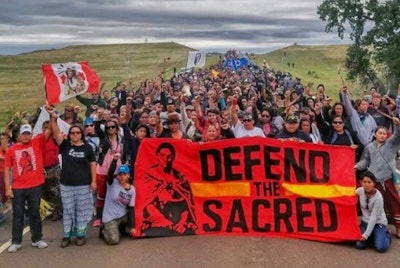The historic battle over the 1170-mile Dakota Access Pipe Line (DAPL) has consequences far beyond the environmental danger posed by what is deep below the Earth’s surface — what is referred to as “zuzeca sape” or the black snake — or the millions of barrels of oil that are slated to move from North Dakota to Illinois. This includes Lakota, Dakota and Nakota lands.

As we see water protectors violently attacked by vicious dogs, batons, pepper spray, grenades and with rubber bullets and militarized vehicles, with some 500 arrests, it conjures up not simply dogs attacking Black civil rights protestors in the early 1960s, but it actually conjures up the vicious war dogs the Spanish conquistadors brought with them to these lands in the early 1500s.
And yet, not to be forgotten is that during the Red, Black and Brown Power era, the American Indian Movement flew the American flag upside down to indicate that this nation is under distress. This indeed is not a new struggle, but today, undoubtedly, it is the Earth that is both in distress and in revolt. Some argue that, as evidenced by climate change, we are in a state of emergency or even in a genuinely American, manmade disaster.
In one sense, in this country, this state of disaster intensified when U.S. politicians, after 9/11, began to refer to this country as “The Homeland” and created the U.S. Department of Homeland Security. America sits on top of Indian lands. That’s why this country is referred to as being a nation of immigrants ― except for Native Americans. Nowadays, many Americans are forgetting that last part. That is what is at the root of the DAPL conflict. The lands in question here are not private property.
Not coincidentally the struggle at Standing Rock is about the water, the air, the Earth and, in the end, it is about our bodies and their dehumanization by the state and private capital. There are larger connections here, and yet not everyone sees these connections. It is about a pipeline and other kinds of pipelines. It is about the connection of all these pipelines across the country. It is about bursting and polluting pipelines and it is about the school-to-prison pipeline, about The New Jim Crow pipeline that Michelle Alexander speaks about, and it is about a deportation pipeline, a pipeline that daily deports hundreds of Indigenous peoples.
In one sense, the story of the human beings, is the smaller story and so we go back to the larger story of the Earth, several billion years old. Earth is in peril, toxic, on fire and endangered.
Yet the biggest gathering of Indian nations, a resistance led by youths and elders, since Wounded Knee in 1973 is in fact the bigger story. Not because these waters are more precious here, but because this desecration (of sacred burial sites) has become the last straw. All these other pipelines have already burst, have cracked and have spilt their poisons everywhere, but especially on Indian lands, which historically have been this nation’s dumping grounds for toxic, chemical and nuclear waste. Who has forgotten the Gold King Mine in which 3 million gallons of toxic wastewater were spilt in 2015 unto rivers on Indian lands in the Four Corners region of the United States?
While the black snake traverses Lakota, Dakota and Nakota territory, not ever to be forgotten is that every square inch of this country and continent continue to be Indian Country. The papal bulls of the 1500s and the “doctrine of discovery” (Pagans in the Promised Land, Newcomb, 2008) that purportedly legitimized the theft of this continent, is just that: bull. These lands have never been ceded. That is what mainstream America appears not to understand, in large part because this has never been taught in this nation’s classrooms ― from its pre-K to its graduate and professional schools. It is why the nations are gathered and will continue to gather.
Dr. Roberto Rodriguez is an associate professor in Mexican American studies at the University of Arizona.





















